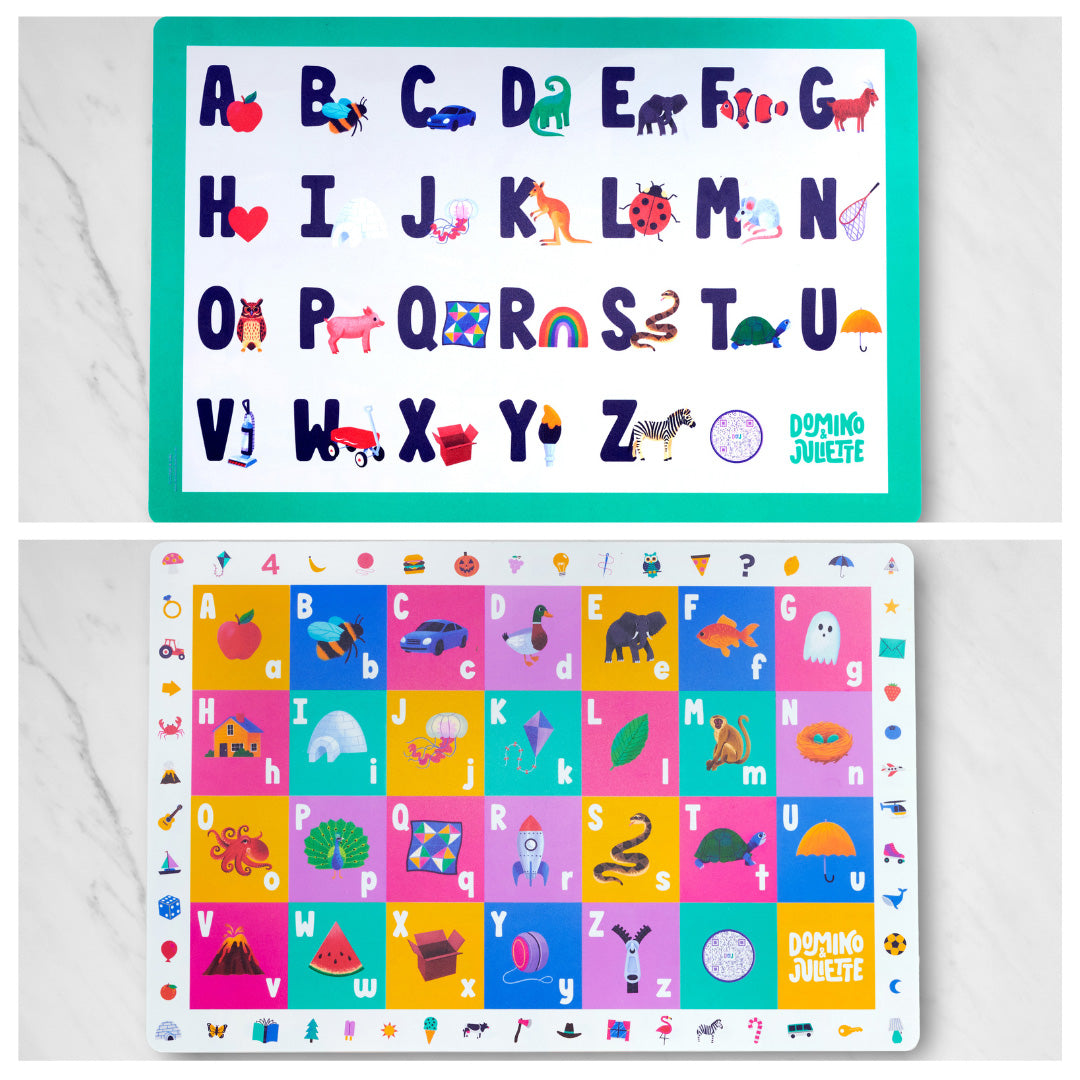
Welcome to the Bright Idea Zone!One toy, many ways to play
Discover a multitude of bright ideas for each placemat and keep the fun fresh. Designed by educational experts and sorted by age and ability, these activities help keep little minds engaged and growing.
For offline play, click to download the printer-friendly version of this page, as well as your bonus printable tools, and begin your learning adventure today!

And you thought you were just getting a mat 😉! The vision at Domino & Juliette is play-to-learn energy coupled with the longevity of toys. We facilitate this through a QR code providing easy access to a bounty of activities you and your child will enjoy. Let's use this Alphabet placemat to have some fun with sounds! Scroll down for a learning guide moving from toddlers up to kindergarteners. See? We’ve got you!
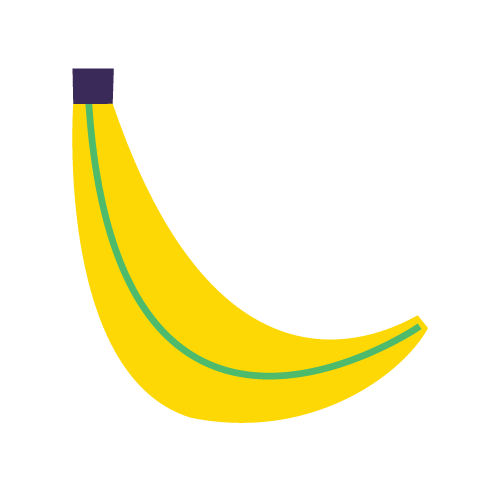
Learning the ABCs!
- Don’t expect your child to learn the entire alphabet at once! Instead, introduce letters to your child in small groups of 4 to 6 at a time. Start with sounds your child might already be making or the beginning sounds they use when communicating. B, P, D and M are great letters to start with when introducing the alphabet!
- Point to these letters and identify the picture that corresponds with the letter on the placemat. Be sure to enunciate the initial sound! For example, “The /B/ sound says “b” like in “bee,” “baby,” and “ball.”
- Focus on the first group of letters daily during mealtimes and play sessions until your child seems to understand. Keep it upbeat and fun! Repetition is crucial.
- Sing the alphabet along the placemat and stop at the letters in the group you are focusing on “J, K, L, M /mmmm/ mouse /mmmm/ mama, N, O …”
- Gather the letters from your D&J ABC Find & Fit puzzle that are a part of the group of letters you are teaching. Trace the letters with your finger and make the beginning sound. Ask your child to point to the sound on the mat saying, “/D/ like DaDa can you find the /D/ on the mat? That’s right, /D/ like dinosaur!”
- It is most important that your child is able to connect the sound with the letter. You can teach your child the names of the letters simultaneously or wait until they understand the sounds, but be sure to focus on the sound the letter makes.
- Note! When teaching the alphabet sounds, make sure you are providing examples that make the same initial sound as the image shown on the placemat. For example, be sure to use /G/ as in goat and not the /J/ sound in giraffe.
- When teaching the letter X, refer to the ending sound /ks/ in the word “box”. Other examples include “fox” and “ax.” Stay away from the word “X-ray” or the /Z/ sound heard in xylophone.
- As your child progresses through learning their letters and sounds, start a new section of letters! Be sure to continue to review the letters and sounds they have already learned. Kids love to show off what they already know!

It’s All About the Sounds!
- Ask your child to find a particular letter by sound. “Point to the /P/ like popsicle.” Continue through all of the letters.
- We’re going on a letter hunt! Using your D&J ABC Find & Fit puzzle pieces (or just grab Post-it notes and write the alphabet on them), spread the letters on the table in scrambled order or hide throughout the room. Encourage your child to find the letters and match them to the correct spots on the placemat.
- Cover it up! - Call out letters or sounds and have your child find the D&J ABC Find & Fit puzzle piece and place it on the corresponding letter on the mat! Alternatively, use D&J bingo chips or snacks (cereal or crackers) to cover the called out letter/sound.
- Guess the missing letter! - Cover up one of the letters and sing the ABCs to figure out the missing letter. Have your child try to form the letters on a Post-it note and stick it onto the corresponding letter on the mat.
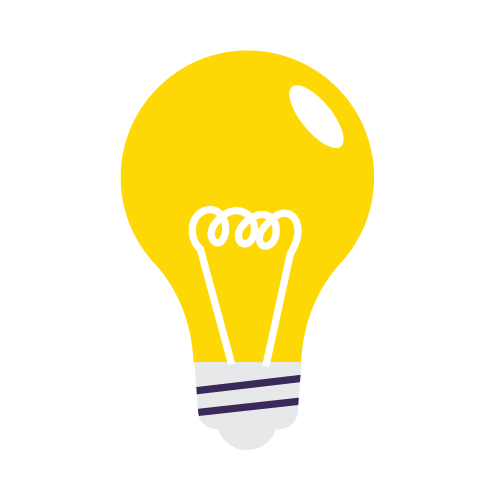
Now You See ‘Em, Now You Write ‘Em!
- First things first: Prior to actually holding a pencil to write, children can begin exploring making letters with playdough, popsicle sticks or Wikki Stix. Use the letters on the mat as a guide as they try to form their own!
- A little more hands-on! Encourage your child to trace the letters on the placemat and make their own using finger paint or tracing on a sand tray.
- Go for it! When ready to start exploring with a writing utensil, have your child practice on paper or a dry erase board using the letters on this mat as a guide. Start with making letters that use vertical and horizontal lines (eg. L, F, E, T, H, I). These are the easiest to create! After working on those, progress to letters with curved-lines (eg. D, B, P, J, O) and then move on to letters with diagonals (eg. A, K, M, N, V).

Take The Next Step…It’s Time For Phonics!
- Ask your child to tell you the first sound they hear in the pictures on the mat. “What is the first sound you hear in the word: leaf?” /L/. It’s okay to emphasize the /L/ by prolonging it!
- Initial Sound Match! Using the pictures, play “I spy” using initial sounds. Example: “I spy a picture that begins with the sound /T/.”
- Another way to play: “I spy a picture that begins the same as bat.” “Bike!” “Yes, bat and bike begin the same!”
- Go beyond the mat and have your child find something in the room with the same initial sound as a picture on the mat! For example, “Can you find something in this room that begins with the same sound as goat?” Work together as a family! Glass! Goldfish! Grandma! Green! Grapes! etc.
- Have your child create new pictures on Post-it notes to place on the letter with the same initial sound. For example, draw a cat and place it on top of the C.
- Personalize it! Have your child use pictures of family members, friends, and favorite characters and place them on top of the corresponding letter on the mat.
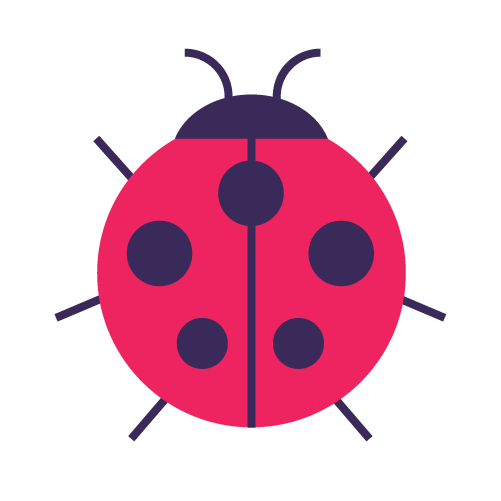
Rhyming
- Point at a picture and say “Does boat rhyme with goat?” Yes or no? Does bug rhyme with car? Yes/no?”
- Point at a picture and provide your child with two other words and ask which ones rhyme. Example: “Which two words rhyme: goat, crab, boat?”
- It’s rhyme time! Think of words that rhyme with a picture. “Let’s think of words that rhyme with goat!”
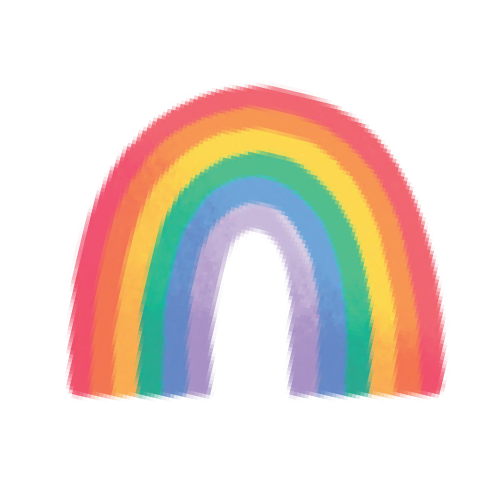
Sure You Play With Toys, But Let’s Play With Letters!
Syllables, oral blending and break-aparts
- First, let’s clap it out! Have your child clap out the syllables/parts of the words.
Example: “bike - 1 clap”, “vac-uum, 2 claps”, “rain-bow, 2 claps” - Now let’s do a little blending: “I’m going to say a word like a robot – sound by sound. Tell me/point to the word I’m saying: /P/ /I/ /G/.”
Child: “Pig!”
This can be turned into an “I spy” game. For example, “I spy a g-oa-t.”
Child points at the goat and says, “goat!” - Follow their pace and when they’re ready, let’s break apart words! Say to your child, “Tell me the sounds you hear in the word, leaf.” or “Let’s tap out the sounds in the word leaf…tap your finger on the table and sound out ‘leaf.’” Child breaks apart the three sounds in the word. Make it fun! This can be turned into an “I spy” game. Example: “I spy a l-ea-f”. Then others guess and point to the image they think the child said.

Conversation Starters: Quick ideas on where to begin!
- Story time! Tell a story using the objects in the row or column
- Pick any two pictures and use those pictures to tell a story.
- Game time! Play “I spy” using the pictures on the placemat.
- Look at the dinosaur next to the letter D. What type of dinosaur do you think that is? What is your favorite type of dinosaur? Why?
- Look at all of the different animals on the placemat. If you could pick one of them to be a pet and live with us in our house, which one would you choose? Why?
- Discuss the animals that live on land vs. water.
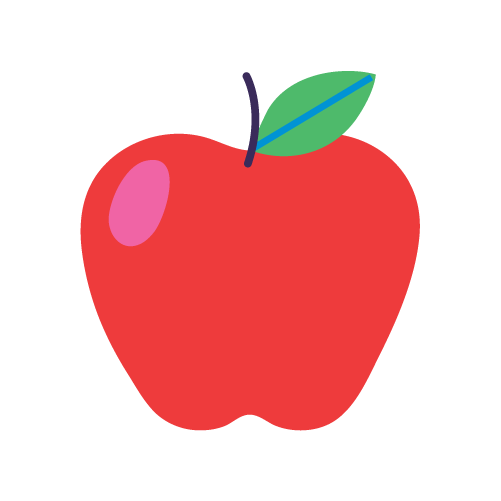
Sort It Out!
Give your child a category and see how many images they can find that are associated with it. Example: “How many things can you find that you can eat?” “How many living things can you find?” “What can you find that you would see in our backyard?”